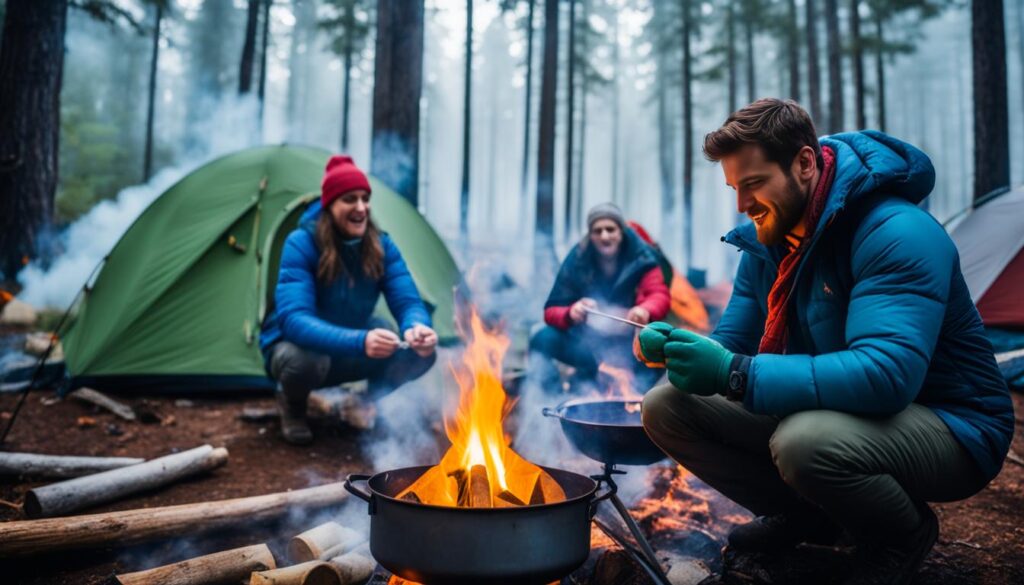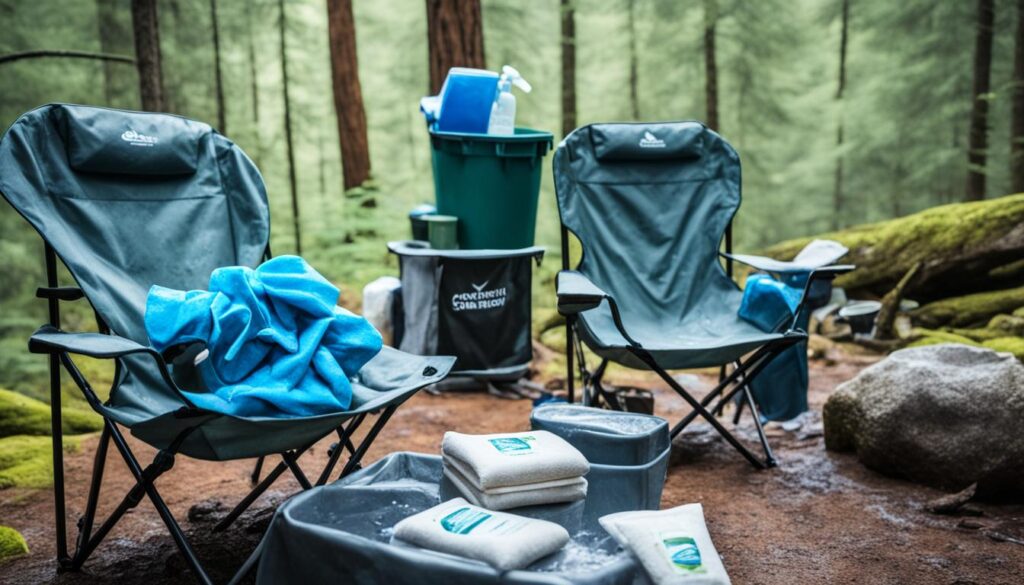When camping in cold weather, it’s crucial to know how to stay warm and comfortable. As an experienced camper, I’ve learned some valuable tips and hacks for staying cozy during outdoor adventures. Whether you’re a novice or a seasoned camper, these strategies will help you brave the chilly nights and enjoy your camping experience to the fullest.
Camping is a fantastic way to connect with nature and escape the hustle and bustle of everyday life. However, the cold temperatures can pose a challenge if you’re not adequately prepared. By following these tips, you can keep warm and make your camping trip enjoyable, no matter the weather conditions.
Key Takeaways:
- Layer underneath your sleeping bag to prevent heat loss through the ground.
- Shake your sleeping bag before use to ensure maximum insulation.
- Avoid tucking your head inside your sleeping bag to prevent moisture buildup.
- Take regular bathroom breaks to maintain a steady body temperature.
- Choose a smaller tent and sleeping bag for better insulation.
Contents
Choose the Right Tent
When camping in cold weather, selecting the right tent is crucial to ensure a warm and comfortable experience. Here are some essential factors to consider when choosing a tent:
- Opt for a smaller tent: Larger tents are harder to heat up and require more effort to maintain a warm interior. Choosing a smaller tent allows for better insulation and quicker heat retention.
- Consider a four-season tent: Four-season tents are specifically designed to withstand cold weather conditions. They provide better insulation and are more resistant to strong winds, ensuring a cozy camping experience.
- Select a sheltered campsite: Look for a campsite that offers natural protection from the wind and receives morning sun exposure. This will help retain heat inside the tent and create a more comfortable environment.
- Pitch your tent tightly: Properly securing your tent and tightening the rainfly helps minimize condensation. By reducing moisture build-up, you can maintain a dry and warm interior.
To find the perfect tent for cold weather camping, consider reputable brands like REI and The North Face. They offer a wide range of camping gear designed specifically for cold weather conditions.
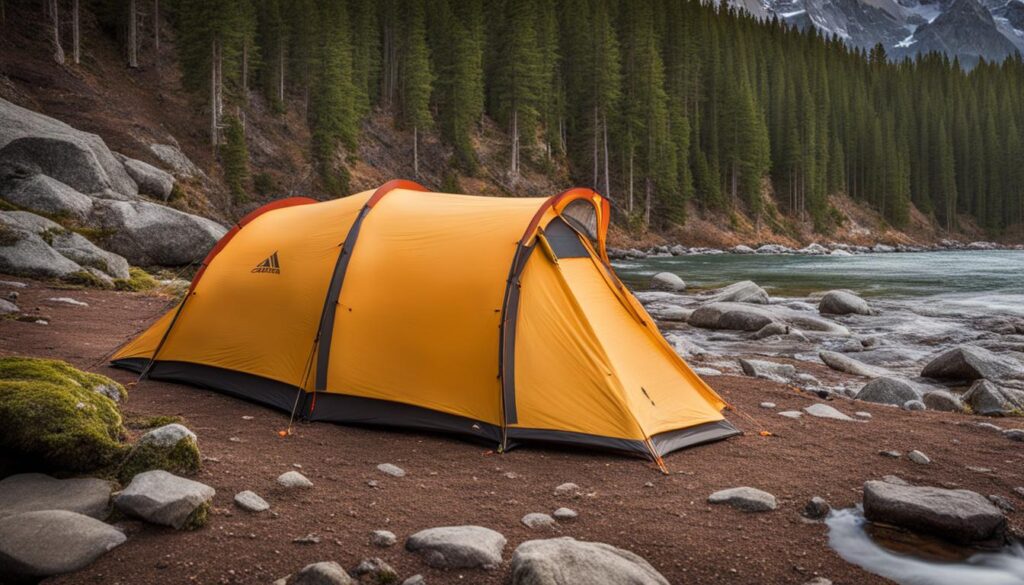
Comparison of Cold Weather Tents
| Tent Brand | Type | Features | Price Range |
|---|---|---|---|
| REI | Four-season | High-quality insulation, durable materials | $300-$800 |
| The North Face | Four-season | Windproof, waterproof, excellent ventilation | $400-$1000 |
| MSR | Four-season | Lightweight, easy setup | $500-$900 |
Choosing the right tent is a crucial step in preparing for camping in cold weather. By considering the size, insulation, and features of the tent, you can create a warm and comfortable shelter for your outdoor adventures.
Fight Condensation
Condensation can make you feel cold and damp inside your tent. To prevent condensation and maintain a comfortable camping experience, consider implementing these tent condensation solutions:
- Pitch your tent tightly: Ensuring a taut pitch allows moisture to pass through the mesh or fabric inner panels, reducing the likelihood of condensation buildup.
- Ventilate your tent: Create airflow within the tent by leaving a vent or the door slightly open. This allows moist air to escape and fresh air to circulate, reducing condensation.
Remember, condensation happens when warm, moist air comes into contact with a cold surface. By addressing these common causes, you can significantly minimize condensation in your tent.
By following these tent condensation prevention tips, you can create a more comfortable and enjoyable camping experience, free from excessive moisture. Stay warm and dry on your next adventure!
| Tent Condensation Prevention Tips | Effectiveness |
|---|---|
| Pitch your tent tightly | Effective |
| Ventilate your tent | Highly effective |
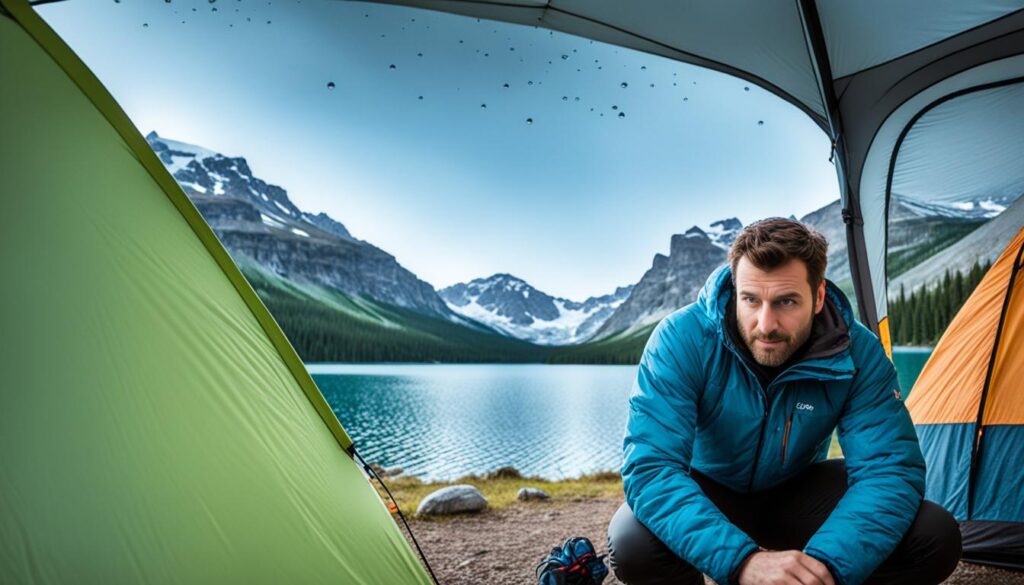
Note: The table above summarizes the effectiveness of the tent condensation prevention tips discussed.
Bring a Warm Sleeping Bag
Your choice of a warm sleeping bag is crucial for staying warm while camping in cold weather. Here are some important factors to consider when selecting a sleeping bag:
- Certified temperature rating: Look for a sleeping bag with a certified temperature rating and choose the appropriate rating for the expected temperatures. This ensures that the bag is designed to keep you warm in the specified temperature range.
- Material: Consider the material of the sleeping bag. Down insulation offers excellent warmth but may not perform well in wet conditions. Synthetic insulation, on the other hand, retains its insulating properties even when wet.
- Weather forecast: Check the weather forecast to determine the temperature range you’ll be camping in. This will help you choose a sleeping bag with the appropriate insulation for the expected conditions.
- Hood: Use a sleeping bag with a hood to keep your head warm. Approximately 7-10% of body heat is lost through the head, so keeping it covered can make a significant difference in staying warm.
- Extra insulation features: Look for a sleeping bag that has additional insulation features such as draft tubes and collars. These features help to prevent cold air from seeping in and keep you cozy throughout the night.
- Proper fit: Choose a sleeping bag that fits your body size. A bag that is too big will leave excess air space, making it harder to stay warm. Conversely, a bag that is too small will be uncomfortable and restrict movement.
- Warm up clothes: Keep tomorrow’s camping clothes inside your sleeping bag overnight. This will pre-warm your clothes and make getting dressed in the morning much more comfortable.
Remember, investing in a high-quality sleeping bag designed for cold weather camping is essential to ensure a warm and restful sleep during your outdoor adventures.
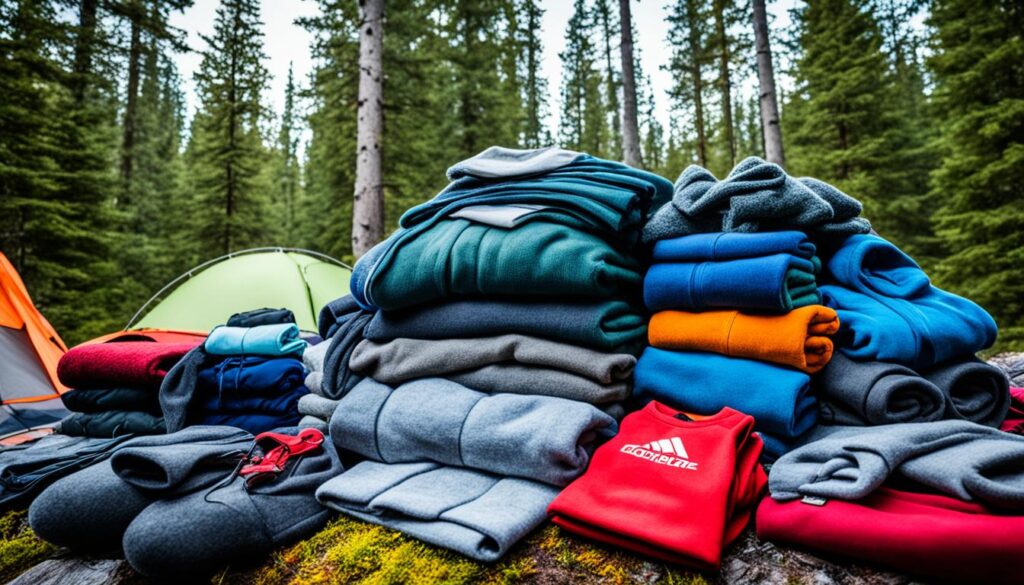
| Sleeping Bag | Temperature Rating | Material | Insulation Features |
|---|---|---|---|
| Brand A | -10°F to 10°F | Down | Draft tubes, collar |
| Brand B | 0°F to 20°F | Synthetic | Draft tubes |
| Brand C | -20°F to 0°F | Down | Draft tubes, collar |
Use an Insulated Sleeping Pad
An insulated sleeping pad is one of the essential camping gear for cold weather and a vital camping essential for warmth. It provides insulation against the cold ground, ensuring a comfortable and warm night’s sleep while camping in chilly conditions.
When choosing a sleeping pad, avoid using air mattresses as they provide little insulation. Instead, opt for an insulated sleeping pad with a high R-value. The R-value measures a pad’s thermal resistance, indicating its ability to minimize heat loss. A higher R-value means better insulation against the cold.
If the weather is exceptionally cold or you need extra warmth, consider layering multiple sleeping pads. This will provide additional insulation and help keep you cozy throughout the night, no matter how low the temperatures drop.
For more detailed tips on staying warm while camping, refer to the REI Co-op Journal’s article, “Tips for Winter Camping: How to Stay Warm Outdoors.”
FAQ
How can I stay warm while camping?
To stay warm while camping, you can:
– Layer underneath your sleeping bag to prevent heat loss through the ground.
– Shake your sleeping bag before use to ensure maximum insulation.
– Avoid tucking your head inside your sleeping bag to prevent moisture buildup.
– Take regular bathroom breaks to maintain a steady body temperature.
– Choose a smaller tent and sleeping bag for better insulation.
– Use hand warmers inside your sleeping bag for added warmth.
– Opt for lithium batteries, which perform better in cold conditions.
– Don’t sleep in all your clothes; layer up intelligently.
– Protect your extremities with hats, socks, and gloves.
– Prepare for freezing temperatures by turning your stove fuel and water upside down and insulating anything that could freeze.
What should I consider when choosing a tent for camping in cold weather?
When choosing a tent for camping in cold weather, consider:
– Opting for a smaller tent, as larger tents are harder to heat up.
– Choosing a four-season tent for better insulation and wind resistance.
– Selecting a campsite that is sheltered from the wind and gets morning sun.
– Pitching your tent tightly to minimize condensation.
How can I reduce condensation inside my tent?
To reduce condensation inside your tent:
– Pitch your tent tightly to allow moisture to pass through the mesh or fabric inner panels.
– Vent your tent by leaving a vent or the door slightly open to allow moisture to escape.
What should I look for in a warm sleeping bag?
When choosing a warm sleeping bag:
– Look for a sleeping bag with a certified temperature rating and choose the appropriate rating for the expected temperatures.
– Consider the material of the sleeping bag; down is warmer but not ideal for wet conditions, while synthetic insulation performs better when wet.
– Check the weather forecast to determine the temperature range and select a sleeping bag accordingly.
– Use a sleeping bag with a hood to keep your head warm.
– Look for a sleeping bag with extra insulation features, such as draft tubes and collars, to keep out cold air.
– Choose a sleeping bag that fits your body size to prevent excess air space.
– Keep tomorrow’s clothing inside your sleeping bag to warm them up for the next day.
Why is an insulated sleeping pad important for camping in cold weather?
An insulated sleeping pad is important for camping in cold weather because it provides insulation against the cold ground. It helps prevent heat loss and keeps you warm and comfortable while sleeping. When choosing an insulated sleeping pad, avoid using air mattresses as they provide little insulation. Look for a pad with a high R-value, and consider layering multiple sleeping pads for increased insulation if necessary.
